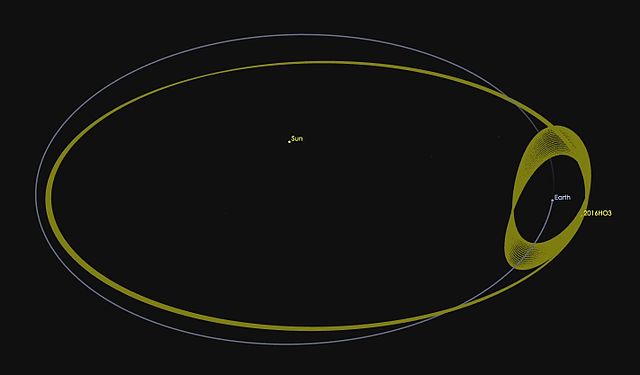Top Qs
Timeline
Chat
Perspective
Tianwen-2
Chinese asteroid and comet exploration mission From Wikipedia, the free encyclopedia
Remove ads
Tianwen-2 (Chinese: 天问二号) is a Chinese asteroid sample return and comet exploration mission that launched on 28 May 2025. The China National Space Agency (CNSA) plans for the probe to return samples from 469219 Kamoʻoalewa—a near-Earth asteroid that is currently a quasi-satellite of Earth—in 2027. After the mothership drops off the sample return vessel to Earth, it is planned to rendezvous with the main-belt comet 311P/PanSTARRS and explore it with its 11 onboard instruments.
Remove ads
Overview
CNSA launched the Tianwen-2 probe using a Long March 3B carrier rocket on 28 May 2025 from the Xichang Satellite Launch Center in southwest China.[8] The probe uses solar electric propulsion for maneuvering between its many objectives.[9] It is planned to explore the co-orbital near-Earth asteroid 469219 Kamoʻoalewa and the main-belt comet 311P/PanSTARRS.[10] The spacecraft will rendezvous with Kamoʻoalewa and conduct remote sensing observations in orbit, before landing on the asteroid to collect a sample of 100 g (3.5 oz) of regolith.[1][11] Explosives will be used to expose potential subsurface volatiles for detection.[4]
The spacecraft will use both anchor-and-attach and touch-and-go methods to attempt collection of a sample from the asteroid. It would be the first time an anchor-and-attach method has been used on an asteroid, as both OSIRIS-REx and Hayabusa2 used touch-and-go.[12]
Tianwen-2 will then return to Earth to drop off a return capsule containing the sample and conduct a gravity assist maneuver to propel the spacecraft toward 311P/PanSTARRS.[13] Remote sensing and in-situ measurements will be conducted at 311P/PanSTARRS for at least one year.[11][14]
Remove ads
History


In 2018, a deep space exploration roadmap covering the 2020–2030 timeframe was proposed by researchers at the Chinese Academy of Sciences,[16] which included an asteroid exploration mission planned for launch around 2022 or 2024.[17][18] Initially, the space probe was known as ZhengHe, with the name referencing the 15th century Ming Dynasty explorer Zheng He.[11] In spring 2019, after a design study for the mission was carried out by the Chinese Academy of Space Technology (CAST), the CNSA began soliciting international proposals for scientific instruments to be carried on Tianwen-2.[11][9][13]
In the planning stages, a nano-orbiter and nano-lander were proposed to be deployed to conduct remote sensing and sampling observations.[19] Also, the original secondary target was 133P/Elst–Pizarro, and a flyby of an additional unnamed asteroid may also have been attempted.[4]
Remove ads
Instruments
Tianwen-2 will incorporate several types of instruments, including wide/narrow angle multispectral and color cameras, a thermal emission spectrometer, a visible/near-infrared imaging spectrometer, a mass spectrometer, a magnetometer, and a charged/neutral particle and dust analyzer.[11][13] International contributions to these payloads are being encouraged.
Scientific payload
Source:[20]
- Visible Infrared Imaging Spectrometer
- Thermal Radiation Spectrometer
- Multispectral Camera
- Medium Field Color Camera
- Detection Radar
- Magnetometer
- Charged and Neutral Particle Analyzers
- Ejecta Analyzer
- Narrow Field of View Navigation Sensor
- Laser Integrated Navigation Sensor
Mission timeline
Remove ads
References
External links
Wikiwand - on
Seamless Wikipedia browsing. On steroids.
Remove ads

